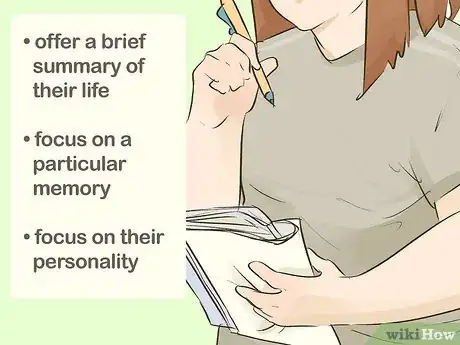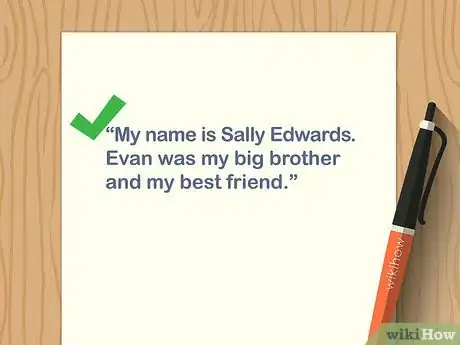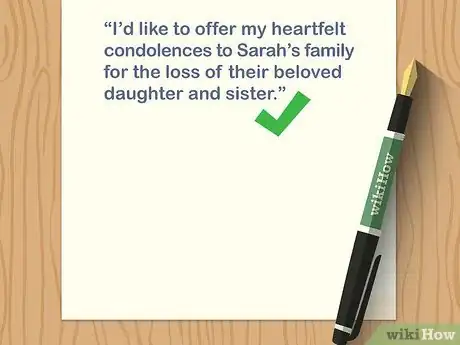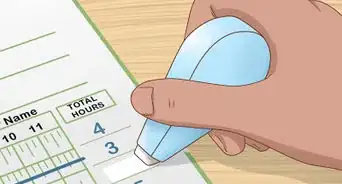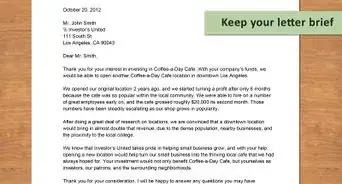This article was co-authored by Lynn Kirkham and by wikiHow staff writer, Megaera Lorenz, PhD. Lynn Kirkham is a Professional Public Speaker and Founder of Yes You Can Speak, a San Francisco Bay Area-based public speaking educational business empowering thousands of professionals to take command of whatever stage they've been given - from job interviews, boardroom talks to TEDx and large conference platforms. Lynn was chosen as the official TEDx Berkeley speaker coach for the last four years and has worked with executives at Google, Facebook, Intuit, Genentech, Intel, VMware, and others.
This article has been viewed 55,957 times.
Being asked to write a eulogy for a departed loved one is a sober responsibility, but it can also be cathartic. This is a chance to honor your friend or family member after their passing and share fond memories with others who were close to them. If you have the task of writing and delivering a eulogy, you may be wondering where to begin. There’s no set structure for eulogies, although you may have a time limit (e.g., 5 minutes). Keep your opening short, clear, and simple. When you’re delivering your opening comments, stick to the script and take your time.
Steps
Writing Your Opening
-
1Define the theme of your eulogy. Before you start writing, consider what you really want to say about your loved one. You might offer a brief summary of their life, focus on a particular memory, or choose an aspect of their personality that you’d like to celebrate. Picking a theme or point of focus can help you organize your thoughts and decide how to structure the whole speech.[1]
- For example, you might decide that you are going to build your eulogy around a favorite personal memory you have of your loved one.
-
2Open with a few words about your relationship to the deceased. Start with a few brief sentences about who you are and how you knew the person who passed away. This will help the audience connect with you and provide context for what you are about to say.[2]
- For example, you might say, “My name is Sally Edwards. Evan was my big brother and my best friend.”
Advertisement -
3Thank the people attending the funeral if you’re family. If you’re an immediate family member of the person who passed, show your appreciation to the people who have come out to honor them. Be sure to especially address people who have traveled a long distance to attend the funeral.
- You might say, “I’d like to thank all of you for coming to Uncle John’s funeral, especially those of you who have flown in from out of state. It means so much to all of us, and I know it would make him so happy to see all of you here.”
-
4Offer your condolences to the family if you aren’t a relative. In some cases, you may be asked to deliver a eulogy for a friend or coworker. If you’re not a member of the deceased person’s family, say a few words to acknowledge the family and their grief.[3]
- For example, you could say, “I’d like to offer my heartfelt condolences to Sarah’s family for the loss of their beloved daughter and sister.”
-
5Summarize what you are going to say in 1 or 2 sentences. Once you’ve written a few introductory words, you can lead into the main body of your eulogy with a short summary or opening line. This will set the tone for the rest of the eulogy.
- You might start with something really simple and straightforward, such as, “I’m going to share one of my favorite memories of Aunt Rosa.”
- If you prefer, you could open with something more attention-grabbing, such as a few words that you feel capture whatever you are trying to say about your loved one. For example, “Phil never went anywhere without his camera and a sense of wonder.”
Delivering the Eulogy Opening
-
1Take a moment to compose yourself before you start. A funeral is always a deeply emotional event, and being asked to stand up and talk about your departed loved one can be especially overwhelming. If you find yourself struggling to start, take a moment to breathe deeply, have a sip of water, and gather your thoughts.[4]
- If you’re nervous or emotional, try to visualize yourself calmly delivering the eulogy before you begin.
- Before you start, close your eyes and picture your loved one as you remember them. Acknowledge your grief, but also think about the good feelings associated with your memories of them.[5]
-
2Keep your notes in front of you. When you’re delivering a eulogy, it’s easy to lose your train of thought or have your mind go blank. While you may know what you’ve written well enough that you don’t have to read it word-for-word, it’s a good idea to have your script in front of you from the start for easy reference.[6]
- Print your script out in a large, easy-to-read font and double space it. That way, you won’t be struggling to read your notes if you lose your place.
-
3Speak slowly and clearly.[7] Focus on keeping your speech deliberate, slow, and even. This will not only make it easier for the audience to understand you, but will also help you stay calm and composed.[8]
- Try to breathe normally. If you’re nervous or emotional, it’s easy to end up breathless or inadvertently hold your breath.
- You may find it helpful to have a glass or bottle of water and some tissues or a handkerchief handy as well.
-
4Look at the audience occasionally if you can. Even if you’re reading from your notes, try to make eye contact with your audience from time to time.[9] This will help you feel more connected with them and make the eulogy feel more like a conversation and less like an impersonal speech.[10]
- Try to directly address the people who were closest to the person who passed away, such as their immediate family.
- You may find that looking at your listeners makes you too emotional, and that’s okay. Don’t try to maintain eye contact if it makes speaking too difficult.
-
5Allow yourself to cry a little if you need to. There’s a good chance you will tear up at some point during your eulogy, even during the opening remarks. If this happens, there’s no need to apologize or feel embarrassed. Just say “Excuse me,” and take a moment to wipe your tears and regain your composure.[11]
- Nobody will hold it against you if you get choked up. This is a difficult and emotional time for everyone present.
Expert Q&A
-
QuestionHow do you deliver a eulogy without crying?
 Lynn KirkhamLynn Kirkham is a Professional Public Speaker and Founder of Yes You Can Speak, a San Francisco Bay Area-based public speaking educational business empowering thousands of professionals to take command of whatever stage they've been given - from job interviews, boardroom talks to TEDx and large conference platforms. Lynn was chosen as the official TEDx Berkeley speaker coach for the last four years and has worked with executives at Google, Facebook, Intuit, Genentech, Intel, VMware, and others.
Lynn KirkhamLynn Kirkham is a Professional Public Speaker and Founder of Yes You Can Speak, a San Francisco Bay Area-based public speaking educational business empowering thousands of professionals to take command of whatever stage they've been given - from job interviews, boardroom talks to TEDx and large conference platforms. Lynn was chosen as the official TEDx Berkeley speaker coach for the last four years and has worked with executives at Google, Facebook, Intuit, Genentech, Intel, VMware, and others.
Public Speaking Coach It's okay to cry, but you might be able to avoid crying by gathering yourself and focusing on your audience. Before you start, calm yourself by taking a deep breath or a sip of water. As you deliver the eulogy, do your best to make eye contact with the people in the audience. This will help you connect with the other mourners.
It's okay to cry, but you might be able to avoid crying by gathering yourself and focusing on your audience. Before you start, calm yourself by taking a deep breath or a sip of water. As you deliver the eulogy, do your best to make eye contact with the people in the audience. This will help you connect with the other mourners.
References
- ↑ https://www.funeralwise.com/celebration-of-life/eulogy/theme/
- ↑ https://www.funeralwise.com/celebration-of-life/eulogy/theme/
- ↑ https://www.funeralwise.com/celebration-of-life/eulogy/
- ↑ Lynn Kirkham. Public Speaking Coach. Expert Interview. 20 November 2019.
- ↑ https://ideas.ted.com/how-to-give-a-eulogy-that-truly-celebrates-the-person-youre-honoring/
- ↑ https://ideas.ted.com/how-to-give-a-eulogy-that-truly-celebrates-the-person-youre-honoring/
- ↑ Lynn Kirkham. Public Speaking Coach. Expert Interview. 20 November 2019.
- ↑ https://humanists.uk/ceremonies/funerals/blog/how-to-deliver-a-eulogy-9-tips-from-a-celebrant/
- ↑ Lynn Kirkham. Public Speaking Coach. Expert Interview. 20 November 2019.
